Welcome to our precision bike fitting system
Precise analysis comes with a collection of body measurements!
Everybody is custom, the bicycle must be a continuation of the
cyclist. Using a quantitative scientific method we match the bicycle
geometry to the cyclist. Maximum performance will be achieved with
a precision custom-fit bike.
It took many years of testing to develop our software. The primary
aim was to provide techniques that support and provide protection
to soft and hard tissues without limiting their function. It is
extremely important to have some basic knowledge of underlying body
structures (e.g. joint and muscle structure) and how a mechanism
works in defense and protection from excessive or repeated stresses.
Cyclist of all ages and abilities are subject to constant mechanical
forces which the body must be prepared to absorb.
The energy that is generated by the muscle has a very small value
and is measured in millionths of a volt (microvolts). It was necessary
to use very sophisticated and sensitive instruments to amplify these
signals so that they could be seen and heard. Without these tools
we would have had to go by outdated concepts and ways to fit you
on your bike.
We used the very best tools known. Force plates to read the forces
under the foot, EMG (electromyography) to study muscle function
through the inquiry of the electrical signal emanating from the
muscle. New technology allowed us to observe synergies in the energy
patterns of muscles that cannot be seen with the naked eye. We observed
muscle energy at rest and as it changed continuously over the course
of a movement. It should be pointed out that simple visual observation
of posture and movement, even with watts readings, do not yield
the same resolution of information as our EMG recordings. Our data
reveal the performance of each muscle, allowing superior assessment
of effort. These analyses have shown that even subtle changes in
postion or pedaling technique can have a large effect on inclusion
or exlcusion of major muscle groups.
To consider the human motor outside the context of a very complex
and interdependent system is not fair. Without having the connective
tissue providing the "sacs" for muscles fibers, the muscles would
not be organized into a meaningful direction of pull, nor would
they be anchored to the bones, and their actions would not produce
movement for your body. Add to that, without a digestive system,
how would there be glucose for the body to burn. Not having lungs,
there would be no oxygen needed for cellular respiration and make
the gas for the muscles-ATP. Without the circulatory system, these
vital substances would not find their way to each and every cell,
nor would their waste products be carried away. And if you did not
have a nervous system, the muscle cells would not know when to fire
or how to orchestrate their firings with other muscles cells to
do what you want them to do. Of all these systems, muscles use more
energy than any part of the body.
There are millions of muscle cells called myofibrils and for these
cells to do their work, they have to shorten from their resting
length via a process of cross-bridging, a ratcheting action of myosin
fibers against actin fibers. Finding this range of motion is key
for using more of these muscle fibers. Get it wrong and you waste
energy! No matter how much effort you use from your mind, they will
not work. If a particular structure is stretched beyond it's "normal"
length, the tissue is more than likely to tear partially or completely
or compress something, leading to discomfort.
Our product is a quantitative solution to place your body and
its muscles in its their best position!!!
By taking precise measurements of the bike rider's anatomy and
obtaining the correct bike geometry, Wobble-naught provides you
with the best "range-of-motion" and best "line-of-pull" for your
muscles to perform work. Our system is based in CAD (computer aided
design) technology.

The measurements we take, including hip size and shape, spine
length and shape, and shoulder range of motion, cannot be generalized
for everyone; we are all individuals and our body measurements reflect
this.
In addition to the Wobble-naught positioning solution, we provide
detailed descriptions on how the fit solution is used to setup the
bike. You can go to the sample output pages from the "About the
fit" menu for detailed descriptions on setting up your bike.
BASIC TOOLS REQUIRED FOR BODY MEASUREMENTS
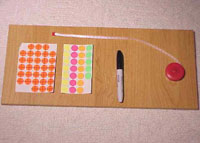 |
Our fit solution requires a few tools:
- self adhesive markers
- a cloth tape measure tape
- a black marker pen
- a carpenters square or book
|
Note: The rider being measured needs someone to
do the measuring.
You cannot do this alone.
Our system uses measurements expressed in metric units. Measuring
in millimeters provides the best accuracy and translates into a
more precise fit. The only data not in millimeters is the rider's
height. Our system will convert this data.
A cloth tape measure can be purchased at places like Wal-Mart.
The tape will have both metric units and inches on it. Use the metric
side - measure in millimeters (e.g. 855 mm not 85.5 cm).
We provide detailed descriptions of the measurements to be taken.
There are digital photos to aid in understanding the descriptions.
Some MPEG video is also provided. Take all the time you need and
get it right before you decide to submit your information.
When you submit the data collected on the Measurement Data Sheet,
your credit card will be charged. Upon credit card approval, which
usually only takes few seconds, you will immediately be provided
with your Wobble-naught Precision Fit Solution. Be sure to print
the Measurement Data Sheet and the Results page for your records.
If you loose this information and you already paid for a fit you
can call us and we can send it out to you again.
With Wobble-naught's Precision Fit Solution in hand, the cleats
and the bike can now be setup. Go to our sample output for help.
You can do this at home or have the work done at your local bike
shop.
Knee pain is the number one injury among cyclists of all levels.
The human body is a link system and it all starts at the foot. The
structure of the foot is determined by the configuration of many
bones. Extreme foot "types" may increase the risk of problems to
the foot, but also add wear and tear to the entire limb and lower
back. Poor pedaling mechanics (particularly after thousands of miles)
is a major cause of injury to cyclists. We strongly recommend replacing
the footbed (or insole) that comes with your shoe with a high quality
orthotic or footbed. There are other products that also can help
make a better interface with the pedal stroke.
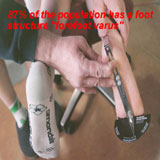 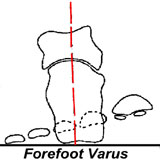 
Some additional tools are required for cleat placement and bike
setup -- a trainer to hold and level the bike, a carpenter's level,
wrenches, and screwdrivers...etc. You will need bike specifications
or an angle measuring instrument to get the effective seat tube
angle or you can go to the frame manufacturers web site which usually
lists these specs.
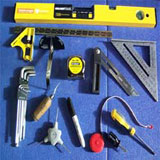 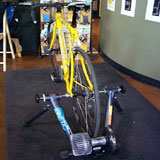 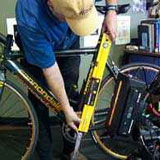
|

